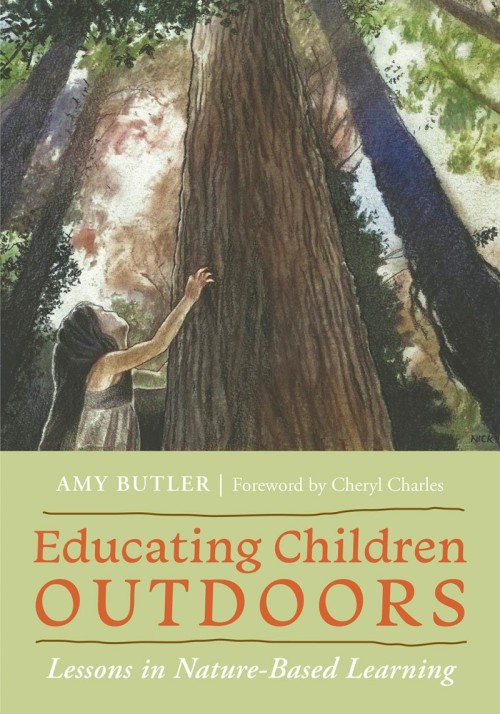by Amy Butler
Cornell University Press, 2024
In Educating Children Outdoors, Amy Butler presents her concentrated nature education knowledge from 13 years of outdoor place-based teaching in Vermont. Masquerading as compelling nature writing, packed with illuminating and inspiring personal stories, and peppered with gorgeous illustrations by artist Nick Neddo, the book is actually a pragmatic guide to safe outdoor teaching.
Butler is the founder of the Educating Children Outdoors (ECO) program at North Branch Nature Center (NBNC), a nonprofit focused on outdoor learning and recreation in central Vermont, with a mission of connecting people with the natural world. Her work at NBNC included serving as director of education. She starts the book by introducing herself and ECO, explaining their entwined history. ECO began organically, seeded by a request from Butler’s local elementary school, and growing as many more Vermont schools joined over the years. “We found ourselves developing a unique co-teaching relationship with the landscape,” she writes. This book is her harvest of down-to-earth advice and includes standardized lesson plans presented in five main learning units.
Before sharing the lesson plans, Butler provides an overview of the structure and philosophy of ECO and outlines core routines that integrate outdoor teaching with classroom experiences. This foundation includes social-emotional learning, creativity and problem-solving, and academic learning goals in every lesson.
Beginning with Unit 1, “Welcome to the Outdoors, Welcome to Nature,” Butler describes specific lessons that introduce a safe, empathic approach to learning outside. These early lessons include building “Mouse Houses,” researching and choosing “Nature Names,” and selecting a “Sit Spot” that will become an integral part of each student’s ongoing relationship with nature and their class.
Unit 2, “Build It and They Will Come: The Power of Sticks,” focuses on building with collected materials. Similarly, Unit 3, “Teaching with Fire: The Heart of an Outdoor Classroom,” centers around building and using fire, including foraging and cooking outside. Because both units involve practical, hands-on skills and tool use, these lessons also teach students safety and self-awareness.
The lessons collected in Unit 4, “Winter Weather, Animals, and Us: Learning Outdoors with Resilience and Wonder,” and Unit 5, “What Does Spring Bring?,” both focus on the special learning opportunities that come with seasonal changes, such as looking for animal prints in snow or greeting newly thawed detritivores.
Throughout the book, Butler conveys a strong safety message. Her philosophy is clear: don’t skip a teaching experience because there are risks of harm, either to children or to nature, instead learn to teach it carefully. She describes cultivating a culture of safety in Chapter 2, and the book’s 13 appendices provide specific support tools, including assessment forms for ecological impact and site hazards; safety protocols and equipment lists; and fire, foraging, and whittling-specific safety checks. After all, Butler argues, “We can’t expect students to fall in love and care for the Earth without touching it and, on some days, getting covered in it.”
One of the reasons I was so keen to read this book, and that I can attest to Butler’s capability, is that my own child participated in ECO as an elementary school student. I was pleased to see how that experience built her confidence in her physical abilities and her willingness to join in outdoor adventures. Whether you are a parent, classroom teacher, or nontraditional educator who is curious about the nature-based education movement, this book will help you develop your own unique teaching relationship with the landscape.


